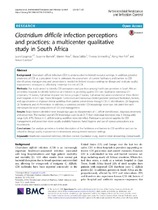| dc.contributor.author | Legenza, Laurel | |
| dc.contributor.author | Barnett, Susanne | |
| dc.contributor.author | Rose, Warren | |
| dc.contributor.author | Safdar, Nasia | |
| dc.contributor.author | Emmerling, Theresa | |
| dc.contributor.author | Hee Peh, Keng | |
| dc.contributor.author | Coetzee, Renier | |
| dc.date.accessioned | 2018-11-05T08:05:14Z | |
| dc.date.available | 2018-11-05T08:05:14Z | |
| dc.date.issued | 2018 | |
| dc.identifier.citation | Legenza, L. et al. (2018). Clostridium difficile infection perceptions and practices: a multicenter qualitative study in South Africa. Antimicrobial Resistance and Infection Control, 7: 125 | en_US |
| dc.identifier.issn | 2047-2994 | |
| dc.identifier.uri | https://doi.org/10.1186/s13756-018-0425-y | |
| dc.identifier.uri | http://hdl.handle.net/10566/4182 | |
| dc.description.abstract | BACKGROUND: Clostridium difficile infection (CDI) is understudied in limited resource settings. In addition, provider
awareness of CDI as a prevalent threat is unknown. An assessment of current facilitators and barriers to CDI
identification, management, and prevention is needed in limited resource settings to design and evaluate quality
improvement strategies to effectively minimize the risk of CDI.
METHODS: Our study aimed to identify CDI perceptions and practices among healthcare providers in South African
secondary hospitals to identify facilitators and barriers to providing quality CDI care. Qualitative interviews (11
physicians, 11 nurses, 4 pharmacists,) and two focus groups (7 nurses, 3 pharmacists) were conducted at three district
level hospitals in the Cape Town Metropole. Semi-structured interviews elicited provider perceived facilitators, barriers,
and opportunities to improve clinical workflow from patient presentation through CDI (1) Identification, (2) Diagnosis,
(3) Treatment, and (4) Prevention. In addition, a summary provider CDI knowledge score was calculated for each
interviewee for seven components of CDI and management.
RESULTS: Major barriers identified were knowledge gaps in characteristics of C. difficile identification, diagnosis, treatment,
and prevention. The median overall CDI knowledge score (scale 0–7) from individual interviews was 3 [interquartile
range 0.25, 4.75]. Delays in C. difficile testing workflow were identified. Participants perceived supplies for CDI
management and prevention were usually available; however, hand hygiene and use of contact precautions was
inconsistent.
CONCLUSIONS: Our analysis provides a detailed description of the facilitators and barriers to CDI workflow and can be
utilized to design quality improvement interventions among limited resource settings. | en_US |
| dc.language.iso | en | en_US |
| dc.publisher | BMC | en_US |
| dc.rights | © The Author(s). 2018 Open Access This article is distributed under the terms of the Creative Commons Attribution 4.0
International License (http://creativecommons.org/licenses/by/4.0/), which permits unrestricted use, distribution, and
reproduction in any medium, provided you give appropriate credit to the original author(s) and the source, provide a link to
the Creative Commons license, and indicate if changes were made. The Creative Commons Public Domain Dedication waiver
(http://creativecommons.org/publicdomain/zero/1.0/) applies to the data made available in this article, unless otherwise stated. | |
| dc.subject | Healthcare associated infection | en_US |
| dc.subject | Infection control | en_US |
| dc.subject | Qualitative study | en_US |
| dc.subject | Antimicrobial stewardship | en_US |
| dc.subject | Global health | en_US |
| dc.title | Clostridium difficile infection perceptions and practices: a multicenter qualitative study in South Africa | en_US |
| dc.type | Article | en_US |
| dc.privacy.showsubmitter | FALSE | |
| dc.status.ispeerreviewed | TRUE | |

